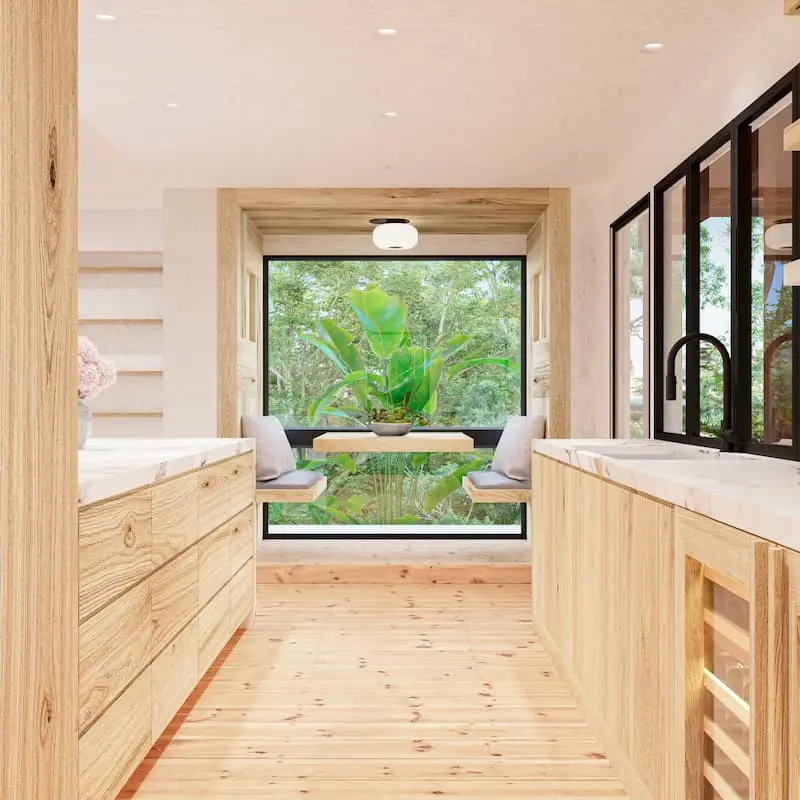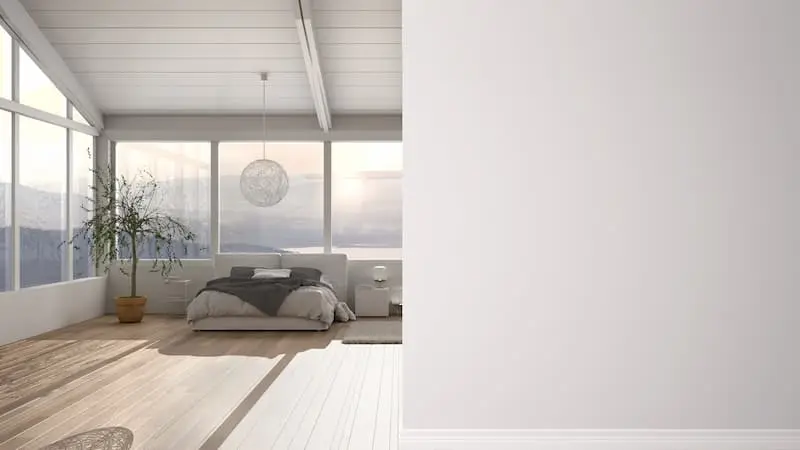Outdoor and indoor living spaces tend to be designed distinctively from each other, but fusing an indoor-outdoor connection that lets space flow seamlessly, has a ton of upside for homeowners.
Creating indoor-outdoor space increases a home’s functionality and quietly elevates the aesthetic. It’s a coveted feature that future homebuyers will seek, adding value. As a prime element of the popular biophilic trend, blurring the boundaries between in and out captures design that makes you feel good, with a lofty, airy sense of space and free-flowing natural light.
What are the benefits of creating an indoor-outdoor connection?
Living spaces that offer hybrid indoor-outdoor opportunities for entertaining or activities such as meditation or exercise increase usable square footage.
Even if the space that extends outdoors isn’t technically that much larger, the home will look and feel bigger, when reframed in wide or invisible sightlines.
Amplifying an awareness of space contributes to calm, creating a more peaceful, pleasant home.
And perhaps most importantly, creating an indoor-outdoor connection contextualizes the benefits offered by biophilic design. Biophilic design centers on the concept that humans are instinctively drawn to the comfort provided from nature, even inside a built environment.
“As we spend more time in our homes and virtual environments, there is an increasing interest in incorporating biophilic design, stemming from our innate desire to connect with nature,” says WELL and LEED accredited interior designer Sarah Barnard.
Creating flowing spaces from the inside out offers the best of both worlds to homeowners: the liberation of living with nature, and the sheltered protection of a built environment.
“Establishing an indoor-outdoor connection can tap into the mental health benefits of being in nature, creating regenerative spaces within our homes that inspire joy in our daily lives,” says Barnard.
Floor plans that generate indoor-outdoor flow
Floor plans that offer indoor-outdoor rooms or adjacent spaces are coveted by homeowners, especially when there is an option for a sunroom, three-season room, screened-in porch, or covered porch.
A sunroom is essentially a space that is mostly enclosed by glass. Windows are typically higher-grade, with coatings that provide insulation, and the room is heated and ventilated appropriately to be used year-round throughout various seasons and weather. Sunrooms are often located adjacent to other outdoor areas (i.e. a back deck, patio, outdoor kitchen), so provide comfortable, sheltered seating with unobstructed views.
Meanwhile, a three-season room offers similar benefits, but typically has lower-grade windows and less insulation, making it usable from spring through fall months.
For outdoor space that still provides shelter, a screened-in porch or a covered porch offers the opportunity to eat or relax outside with sun and rain protection, with a screened-in porch extending greater protection against pests.
The best part of all of these spaces is the perceived immersion in nature, with added comfort.
Windows, sliding doors and glass walls
You don’t necessarily a dedicated room to achieve an indoor-outdoor connection. Window size, style and placement can help to establish one instead.
“Large windows provide scenic views of the outdoor landscape connect our interior spaces to the natural world and provide an abundance of natural light,” says Barnard.
Access to natural light is a pillar in establishing an indoor-outdoor connection, so design choices should be strategic to support supply and distribution of light.
“Window treatments and dimmable lamps provide options to regulate light throughout the day in accordance with the rising and setting sun, which can positively affect our circadian rhythm and sleep patterns,” she says.
Panoramic windows, floor-to-ceiling windows and bay windows can all play a role in packaging and delivering outdoor vistas. Corner windows wrap around to authentically offer multiple points of view, like you would experience outside.
Window seats are trending, particularly in bedrooms, where you can sit comfortably and enjoy the view with built-in seating.
Another popular and beautiful way to integrate outdoor space are with glass walls or sliding glass doors. Glass walls and traditional sliding doors provide substantial outward views, while full sliding glass door systems lets homeowners easily retract the walls to instantly and seamlessly expand their living area.
They effectively remove sightline obstructions between a home’s interior and exterior.
Strategic design and décor choices
Fusing indoor and outdoor space relies heavily on visual perception, and choosing the right design elements that are both subtle and compelling will draw the eye in precisely the right direction. Supporting décor will emphasise what the eye already sees: a connection with nature.
“Selecting a neutral palette of colors from the natural world is a great place to start when blending indoor and outdoor living,” says Barnard. Think greens, blues, taupes and corals.
Integrating natural materials in the interior décor mimics what is found outside, and can help to maintain a cohesive design, also important in maintaining sightlines.
“Natural materials such as hardwood flooring or a unique stone slab can be harmoniously incorporated,” says Barnard.
“Wallpaper and textile designs that depict imagery and decorative patterns influenced by nature can be a great way to incorporate biophilic design into the home,” says Barnard.
Including plants and other greenery inside can help establish a visual connection beyond the windows. They also promote calm and clean the air.
“These green spaces create beauty, inspire mindfulness, and can improve the air quality of our interiors,” says Barnard.
Embrace symmetry in indoor-outdoor spaces that are near each other, with entertainment areas on either side of the invisible line. Configure outdoor furniture so that it is cohesive with indoor entertaining space layout and style, which will make it appear as one larger room with different zones. Having indoor-outdoor furniture lets you be more flexible with your choices.
Reduce visual barriers at every opportunity, which may include opting for recessed lighting or translucent fixtures. Remember to include lighting in your outdoor space as well with post, patio, garden or deck lighting.
Some interior floor finishes can extend to the outside for a cohesive aesthetic, but ensure that they are weather-ready. Having similar, complementary finishes works too, and you can connect the spaces with matching outdoor-indoor throw rugs. Regardless of material choices, aim for minimal transitions to as not to interrupt sightlines.








